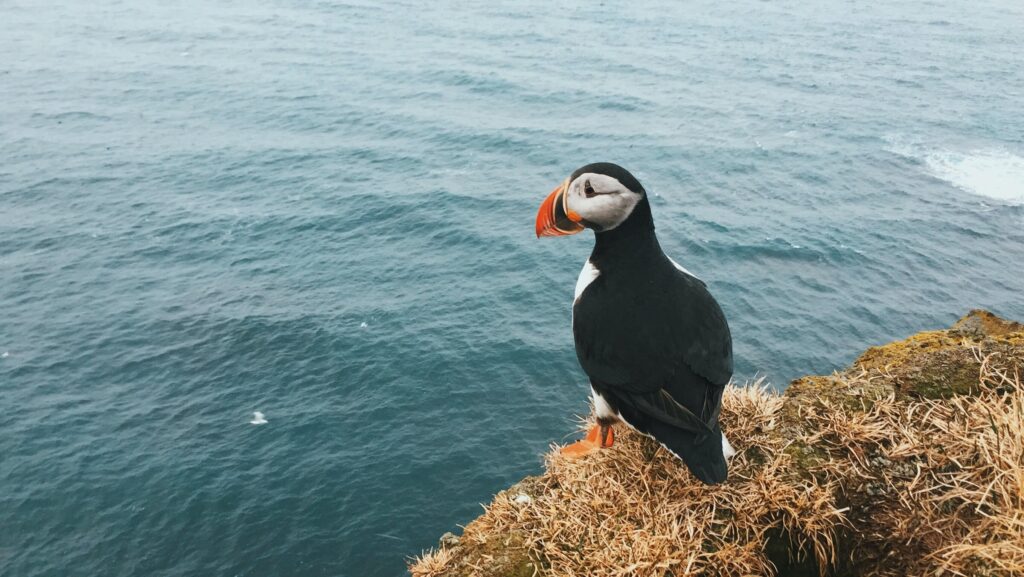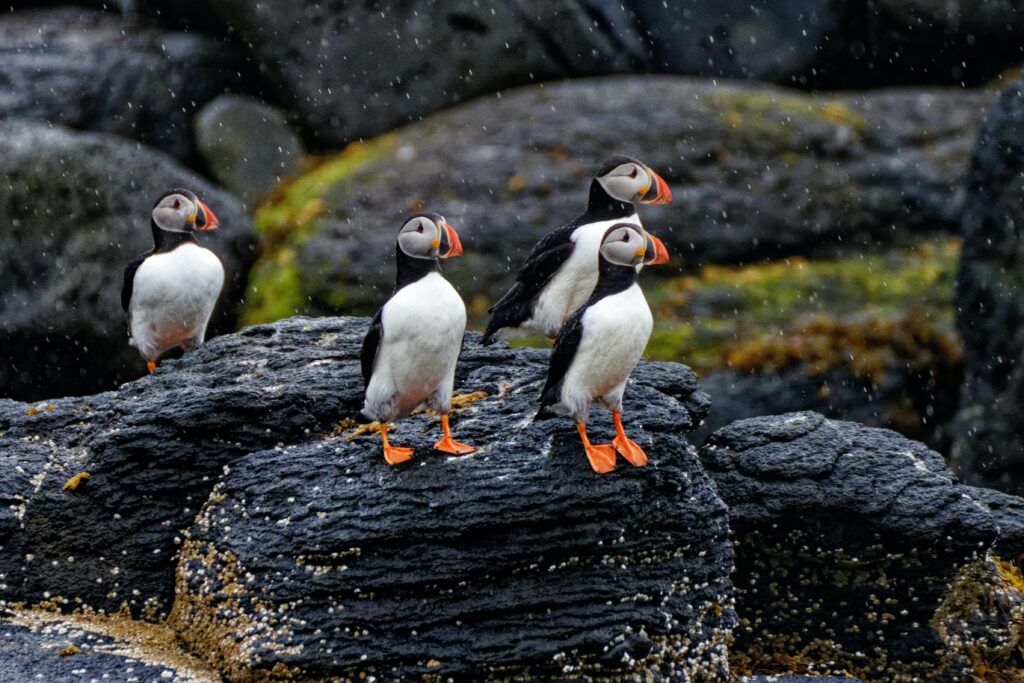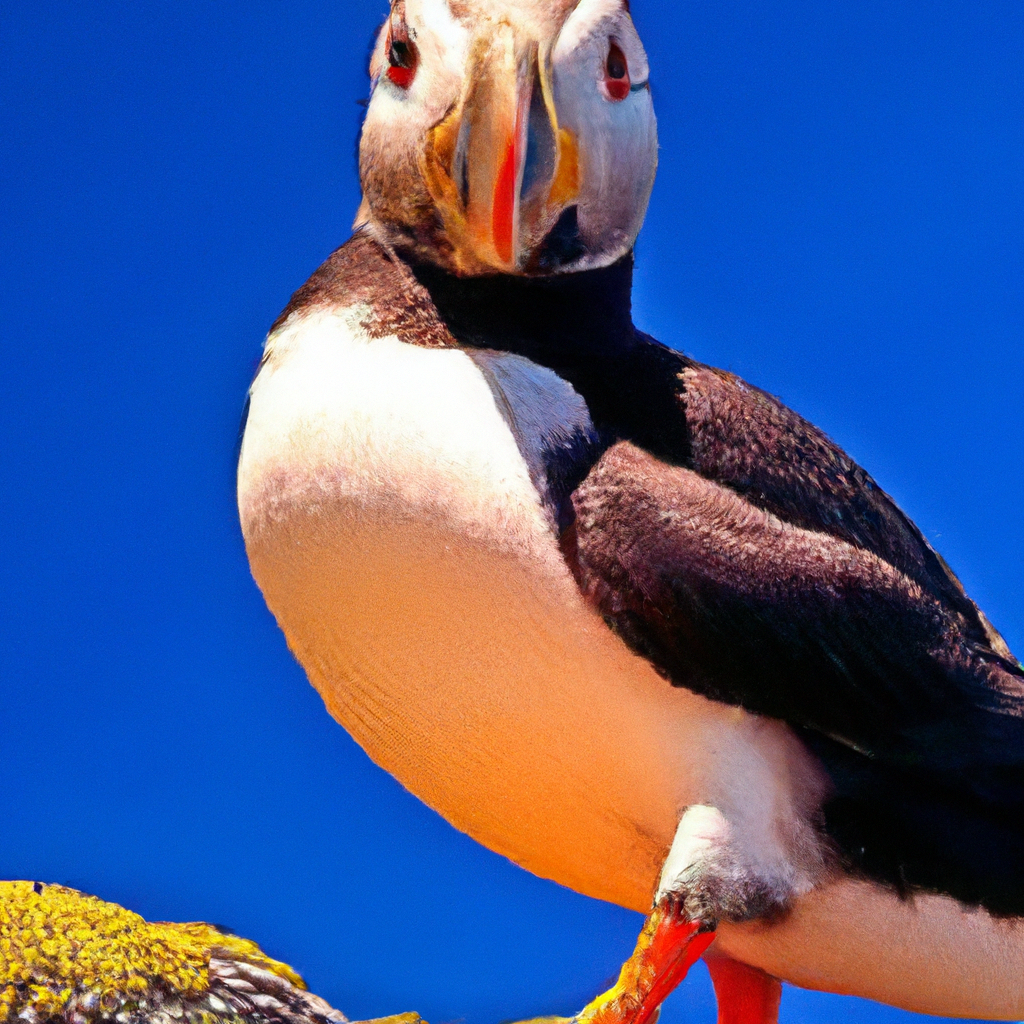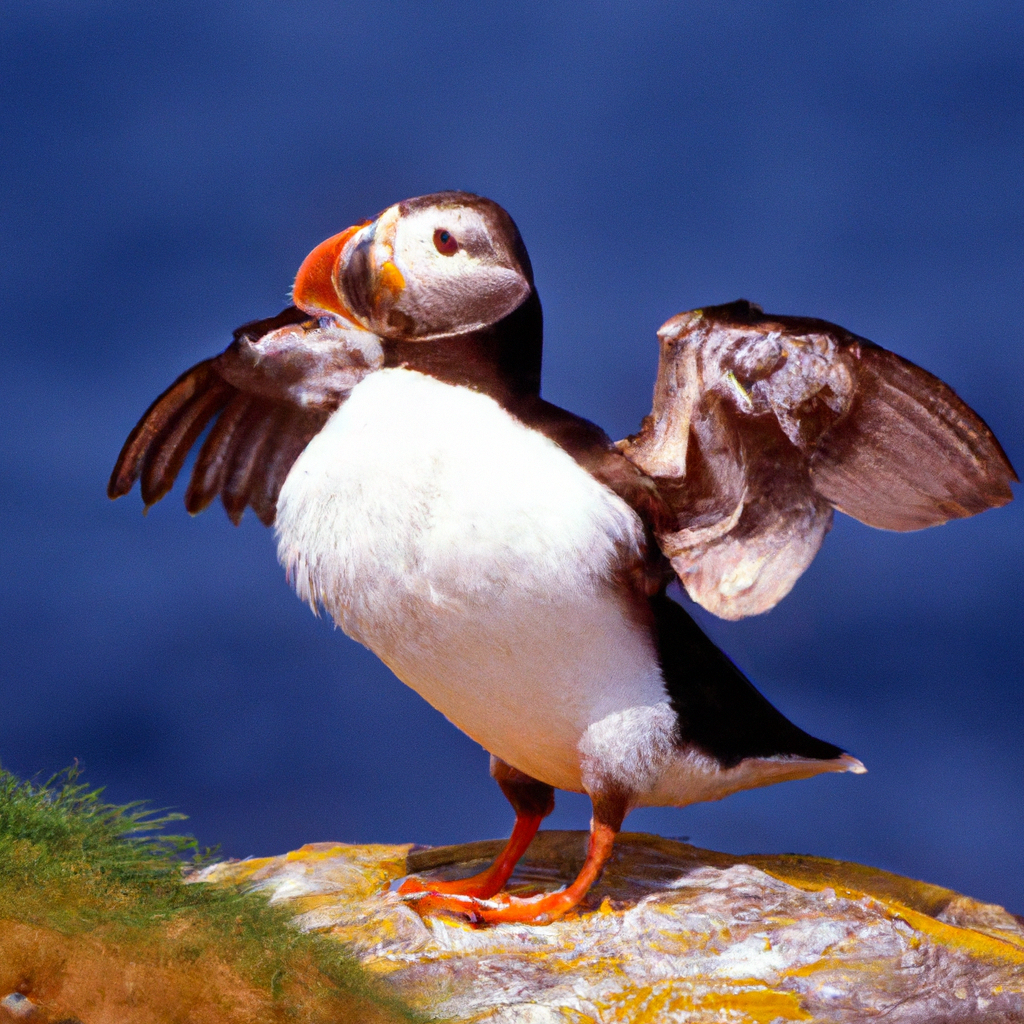The Puffin, scientific name Fratercula, is a fascinating bird species that has captured the attention of bird enthusiasts worldwide. Known for its distinctive appearance and amusing behaviors, the Puffin stands out among its avian counterparts. With its black and white plumage, colorful beak, and distinctive upright stance, the Puffin is truly a sight to behold. In this article, we will explore the intriguing characteristics and habits of this remarkable species, shedding light on its unique features and shedding light on its remarkable adaptations to life both on land and at sea.

This image is property of images.unsplash.com.
Appearance
Physical Description
The puffin, scientifically known as Fratercula, is a medium-sized seabird that has a distinct appearance. It has a compact body, measuring around 30 centimeters in length, with short wings and a stocky build. The most notable feature of the puffin is its large, colorful beak, which is vibrant orange during the breeding season. This striking beak is triangular in shape, with a ridged upper mandible and a sharp, pointed tip. The rest of its body is predominantly black, with white underparts and a white face contrasting with its dark back.
Coloration
During the breeding season, adult puffins display stunning colors that add to their charm. Their beak, as mentioned earlier, is a vibrant orange, while their eyes are a bright, piercing orange-red. These eye-catching colors serve an important purpose in attracting potential mates. Outside of the breeding season, the puffin’s face loses some of its brightness, with the beak fading to a duller yellowish color. Additionally, the plumage on the bird’s back takes on a more faded appearance, becoming a mix of grey and black, although the contrast between the black and white underparts remains prominent.
Habitat
Geographical Range
Puffins are known to inhabit the northern parts of the Atlantic Ocean, as well as the eastern and western parts of the North Pacific Ocean. They have a wide geographical range, with their breeding colonies spanning across various countries. Notable places where puffins can be found include Iceland, Norway, the Faroe Islands, Canada, and the United States. These birds are highly adaptive and have been observed in diverse habitats, ranging from remote offshore islands to coastal cliffs.
Nesting Sites
Puffins are colonial nesters and prefer to establish their breeding colonies on cliffs or steep slopes that offer protection from potential predators. They are well-known for their impressive burrow-nesting behavior. Puffins excavate burrows in the soil or find suitable crevices in rocky cliffs where they can create their nests. These burrows can extend up to several feet in length, providing a safe and secure environment for incubating their eggs and raising their chicks. The puffin’s burrowing strategy offers excellent insulation against the elements and serves as protection from predators.
Diet
Preferred Prey
Puffins have a diverse diet consisting mainly of small fish and marine invertebrates. Their preferred prey includes sand eels, herring, capelin, and sprats. These species of fish are abundant in the puffin’s habitat and provide a reliable food source for their population. In addition to fish, puffins also feed on crustaceans and zooplankton, with the specific prey varying slightly depending on the availability in their respective feeding grounds.
Feeding Behaviors
Puffins are excellent divers and have adapted to catch their prey underwater. They use their wings to propel themselves through the water, using their webbed feet as rudders to navigate. Once they spot their target, they dive down to depths of around 60 meters (200 feet), using their wings to swim and their specially designed beaks to snatch their prey. Puffins are capable of carrying multiple fish in their beaks, thanks to the unique hinged joint that allows them to hold a considerable amount of food. After catching their prey, the birds return to their nests or burrows to feed themselves and their chicks.
Breeding
Mating Rituals
Puffins are monogamous and form long-term pair bonds. Their breeding season begins in the spring, and during this time, the birds engage in elaborate courtship displays to attract a mate. These displays involve various behaviors, including head movements, bill clacking, and mutual preening. The male puffin will also bring a small fish or gift to the female as part of the courtship ritual. Once a pair bond is formed, the puffins will return to the same breeding site year after year, reinforcing their bond and ensuring successful reproduction.
Nesting and Parental Care
After the pair bond is established, the puffins proceed to prepare their nesting burrow. The female lays a single egg, and both parents take turns incubating it for about six weeks. During this incubation period, the parents share the responsibility of keeping the egg warm and protected. Once the egg hatches, both parents continue to care for the chick, providing it with regurgitated fish for nourishment. The fledgling remains in the burrow for several weeks until it is ready to fledge and venture out into the open sea.

This image is property of images.unsplash.com.
Behavior
Flight Patterns
Puffins are agile flyers, capable of reaching impressive speeds in the air. They have powerful wings that allow them to fly with rapid wingbeats, and their petite size aids their maneuverability. When in flight, puffins can clock speeds of up to 80 kilometers per hour (50 miles per hour). Their wingspan spans approximately 46-63 centimeters (18-25 inches), enabling them to swiftly navigate across their oceanic habitats.
Social Interactions
Puffins are sociable birds, and their colonies often consist of thousands of individuals. Within these colonies, there is a complex social structure that includes courtship, pair bonding, and territorial behaviors. Puffins are generally peaceful and will coexist harmoniously, but they can become territorial during the breeding season, protecting their nesting burrows from intruders. They establish specific territories within the colony and defend them against competing individuals by engaging in aggressive displays and vocalizations.
Threats
Predators
Predation is a significant threat to puffins, both during the breeding season and while they are at sea. On land, predatory mammals such as foxes, rats, and mink pose a risk to puffin populations, particularly on islands where these predators have been introduced. In the water, larger marine predators such as sharks, seals, and certain species of dolphins may prey on puffins, especially when they are diving for food. Gulls and other predatory birds also pose a threat by targeting puffin eggs or vulnerable chicks.
Human Activities
Human activities have had a detrimental impact on puffin populations. Overfishing and the depletion of prey species have made it more challenging for puffins to find an adequate food supply, leading to malnutrition and reduced breeding success. Pollution, including oil spills and marine debris, poses a danger to their habitats and the overall health of the marine ecosystem. Additionally, disturbance caused by human presence, such as invasive tourism practices, can disrupt breeding colonies and cause stress to puffins.

This image is property of images.unsplash.com.
Conservation
Protective Measures
Efforts are underway to protect puffins and conserve their habitats. These include the establishment of protected areas and marine reserves to safeguard important breeding sites and foraging grounds. Conservation organizations work towards reducing the impact of introduced predators by implementing predator control programs on islands where puffins breed. Conservationists also collaborate with fishing industries to promote sustainable fishing practices that ensure an adequate food supply for puffins and other marine wildlife.
Population Status
The population status of puffins varies across different regions and species. Some puffin populations have experienced significant declines over the years, while others have remained relatively stable. The International Union for Conservation of Nature (IUCN) lists several species of puffins as “vulnerable” or “near threatened” due to the threats they face. Monitoring and research efforts are crucial for gathering data on puffin populations to inform conservation strategies and ensure the long-term survival of these fascinating seabirds.
Related Species
Other Fratercula Species
Puffins belong to the Fratercula genus, which includes several other species. These species share many similarities in terms of physical appearance and ecological preferences. The most well-known puffin species include the Atlantic puffin (Fratercula arctica), the horned puffin (Fratercula corniculata), and the tufted puffin (Fratercula cirrhata). Each species has its own unique characteristics and distribution, but they all play vital roles in their respective ecosystems.
Closely Related Seabirds
Puffins have close relatives within the seabird family. They are part of the Alcidae family, which also includes species such as auks, murres, and guillemots. These birds share similar lifestyles, breeding behaviors, and ecological roles. The family Alcidae comprises an important group of seabirds that thrive in marine ecosystems worldwide, contributing to the overall biodiversity and functioning of coastal and offshore habitats.

Role in Ecosystem
Ecological Importance
Puffins play a crucial role in the marine ecosystems they inhabit. As predators, they help control populations of small fish and marine invertebrates, helping to maintain a balanced ecosystem. Puffins also contribute to nutrient cycling by consuming fish and redistributing valuable nutrients from the marine environment to their breeding colonies through their excrement. Additionally, puffins provide nesting habitat and burrows for other seabirds and marine organisms, thereby supporting overall biodiversity.
Predator-Prey Relationships
Puffins have complex predator-prey relationships within their ecosystems. As predators themselves, they are known to consume a variety of fish and invertebrates, contributing to the regulation of their prey populations. In turn, puffins are preyed upon by larger marine predators, including sharks, seals, and certain birds of prey. These interactions help maintain a delicate balance within the food web, with puffins occupying a significant position as both predators and prey.
Cultural Significance
Symbolism and Folklore
Puffins hold cultural significance in various regions of the world and are often associated with specific folklore and symbolism. In many coastal communities, puffins are considered symbols of good luck and are sometimes referred to as the “clowns of the sea” due to their comical appearance and behavior. In some cultures, puffins are believed to bring messages from the spirit world or represent love, loyalty, and the joy of life. Their distinctive appearance and endearing nature have made them subjects of art, literature, and local traditions.
Tourism and Economy
Puffins have become popular attractions for ecotourism, drawing visitors to coastal locations where they breed and nest. Many people are captivated by the unique experience of observing these charismatic birds up close and engaging in wildlife-watching activities. This interest in puffins has led to the development of sustainable tourism initiatives that generate economic benefits for local communities, promoting conservation and helping raise awareness about the need to protect these remarkable seabirds and their habitats.
In conclusion, puffins are fascinating seabirds with distinct physical characteristics and behaviors. They thrive in a range of habitats, but their populations face various threats that require conservation efforts. Puffins play important roles in the ecosystems they inhabit, and their cultural significance and economic value highlight the need to conserve these captivating birds for future generations to enjoy. By implementing protective measures and promoting sustainable practices, we can ensure the survival of puffins and the preservation of our marine ecosystems.

